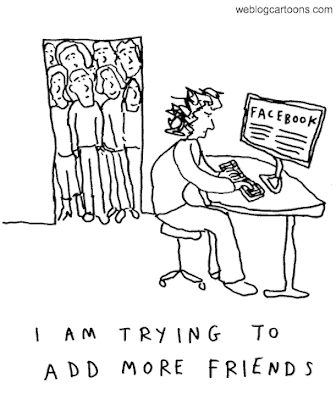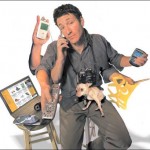By Alexandra Yellin
The Psychology of Facebook
Psych Central’s April Fool’s Day Joke for 2011 was an article that read: “Facebook Revealed to be Psychology Experiment Gone Wrong.” The author used a fake source of Harvard University and several quotes from ‘professor of psychology’ Mark Zuckerberg. This article seemed pretty believable…for about a day.

The researchers behind this project claimed to be interested in “whether or not people in the class would immediately become competitive and try and gain as many friends as possible.” And though this research experiment is far from the truth, the psychological implications of Facebook are certainly a reality.
Rishi Bandopadhay of PsyBlog equated Facebook networking to a competitive sport. He listed 7 rules to ‘get ahead’ using Facebook.
- Get between 100 and 300 friends. (You don’t want to look like a loner, or like you are trying too hard)
- Court attractive friends (Walther et al. (2008) found that attractive friends boosted the perceived attractiveness of participant’s profiles)
- Understand the 7 motivations (Joinson (2008) found 7 basic motivations for using Facebook: connecting with old or distant friends, social surveillance (see what old friends are up to, but without talking to them), looking up people met offline, virtual people watching, status updating and content)
- Don’t let your partner use Facebook (Muise et al. (2009) found that the more time spent on Facebook, the more jealousy)
- Guard your privacy
- Display your real self
- Use Facebook to get a job
Is Facebook really this competitive? I can’t remember the last time I noted how many Facebook friends someone had or judged their popularity by their friends’ good looks. Facebook can also tell you a lot about someone’s personality.
Buffardi and Campbell of the University of Georgia found that individuals’ level of activity on their social networking website is strongly correlated to their level of narcissism; this finding is relatively obvious. It’s easy to see which friends of ours, whose ‘activities’ constantly show up on our newsfeed, are self-centered.

Next Orr, Sisic, Ross, Simmering, and Arseneault set out to study correlations of shyness to various aspects of social networking websites. They found that shy people spend considerably more time on Facebook than people who are not; however, these shy people also had considerably fewer friends, despite their increased time spent on Facebook. So the quiet kid who sits in the back of your Statistics class has probably Facebook stalked you, but you’ll never be receiving a friend request because that person does not have the guts to hit “Send Request.”
Psych Central– Facebook Revealed to be a Psychology Experiment Gone Wrong
PsyBlog– Facebook: 7 Highly Effective Habits
The Layman’s Guide to Psychology– The Psychology of Twitter, Facebook, and other Social Networking Devices
Dr. Kent Kiehl Dabbles in Psychopathology
Crime is a trillion-dollar-a-year problem with the average psychopath convicted of four violent crimes by the age of forty. Although psychopathy is one of the least-funded areas of psychology, Dr. Kent Kiehl, one of the leading investigators in this field, hopes to defy this standard.
In January 2007, he requested to have a portable fMRI brought into the Western New Mexico Correctional Facility; the first fMRI ever brought into a prison. Kiehl hopes to test his theory that psychopathology is caused by a defect in the paralimbic system, which is involved in processing emotion, inhibition, and attention control.
 More
More
Reality Television's Pica Craze
It seems that TLC’s latest tactic to garner higher ratings is by the exploitation of those suffering from pica, a disease where people feel the compulsion to eat things that are not food.
See a video here: Kesha has an "addiction" to eating toilet paper!
“My Strange Addiction” features a number of people with obsessions ranging from odd to dangerous, and a good third of the participants this season are clearly, to anyone who has taken an Abnormal Psychology class, suffering from pica. So far this season, people consumed toilet paper, household cleanser, detergent and soap, couch cushions, and glass. On a recent episode a man even swallowed bullets.
Pica is a serious condition. It can lead to the abnormal ingestion of dangerous chemicals, nutritional deficiencies, blockages in the digestive tract, tears in the intestines, and infections.
One featured addict, Crystal, ingested the household cleaner Comet for 30 years. After an inevitable trip to the dentist, she was informed that the majority of her teeth had eroded-- even at the root. Crystal’s dentist said her condition was the equivalent to a “meth mouth.” Restoring her teeth took months of dental surgery totaling over $20,000.

Pica is typically a childhood occurrence usually lasting a few months, but those featured on this show are adults and they clearly need help. The producers of “My Strange Addiction” claim to help those featured on the show seek help. Every participant is encouraged to attend intensive therapy because behavioral counseling is the most widely used treatment for this incurable disease.
Staying in therapy after the filming of the show ends is not obligatory. At the end of Episode 3, Crystal’s chances of remaining in therapy seemed slim. Her disorder stems from her difficult childhood that started with sexual abuse. Her problem needs serious attention, and should not to be featured as some sort of novelty on a reality TV show.
If “My Strange Addiction’s” producers worked to ensure that the sufferers on the show committed themselves to a therapy plan, it might be acceptable to have a show of this nature. The way the program is currently set up, those involved with “My Strange Addiction’s” production are no longer simply innocent bystanders. There may be no law saying that when you see someone in trouble you are supposed to help them, but this is not a political issue; it’s a moral one. The creators of this program are morally obligated to help these ill individuals instead of solely using them to make money.
Works Cited:
My Strange Addiction Focuses on Unusual Obsessive Behavior - ABC News
Mental Health and Pica - WebMD
Dentist Helps Metro Detroit Woman Addicted to Comet Cleaner - Fox
Time to Mix it Up: The Student Guide to Good Study Habits
We’re told to find ourselves a quiet nook, to maintain a schedule, and to tackle one subject at a time. Our parents tell us that naps are a waste of time. And mass media conglomerates encourage us to fill every spare moment with a quick video clip or a two-minute game on our cell phones. But as it turns out, it is time to quit buying into what we’re told creates the optimal environment and habits to learn.
First, forget about holing up at that same seldom-visited spot over the span of time before an exam. Studies have found that students who vary where they study will remember the information better than those who stay in one place. The brain makes associations between what we study and where we study it, so the greater the number of associations, the more enriched the material, and the better entrenched the memory.

Experts advise students never to have a "go-to" study spot; changing locations can help students better learn the information.
Next, throw the one-subject-at-a-time approach out the window. Varying the type of material studied in one session has been shown to leave a deeper impression on the brain than focusing on a single topic at a time.
For example, a recent study in the journal of Applied Cognitive Psychology featured two groups of 4th graders being taught how to calculate the dimensions of a prism. There were four existing problem sets; one subject group was given repeated examples of one type of problem, while the other was given a mix of all four types of problems. A day later the groups were given separate tests on what they had learned, and the 4th graders who had been given the mixed problem sets performed twice as well.
Last but not least, when you have some down time, take the airplane approach: turn off all your electronics and take a nap. This technological age encourages nearly constant multitasking, but multitasking deprives our brains of much-needed rest. A continuous stream of digital input-via cell phones, iPods, computer screens, and televisions- forfeits the time when our minds could better learn and remember information, even form ideas.

Don't be this guy: Overloading your brain might appear to save you time, but in the end it impairs your learning abilities.
A study at UC-San Francisco found that rats do not process new information and transform it into a persistent memory until they are given a break from those new experiences. Thus in order for us to process what we’ve learned and experienced during the day, we need to rest our brains.
Recent studies have shown that sleep not only consolidates what you have already studied, but it also primes the mind for further learning. So an afternoon nap between classes (as long as you set your alarm) can actually be the final element to a perfect study system.
For Reference:
Think You Know How to Study? Think Again- NPR
Digital Devices Deprive Brain of Needed Downtime- The New York Times
Forget What You Know About Good Study Habits- The New York Times
Behavior: Napping Can Prime the Brain for Learning- The New York Times